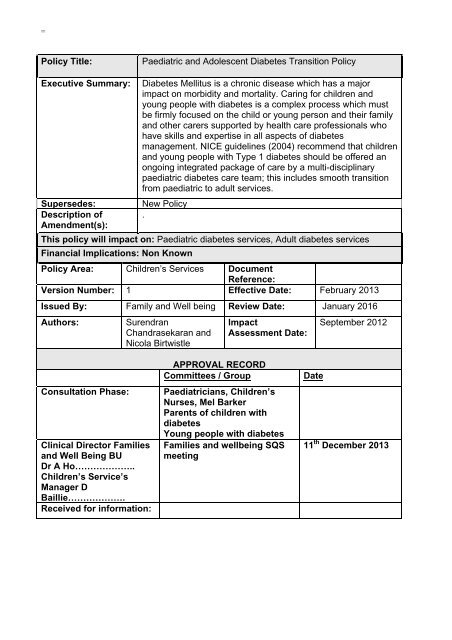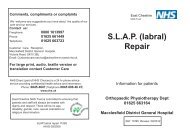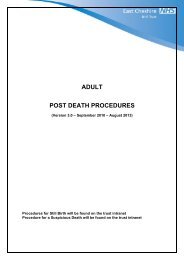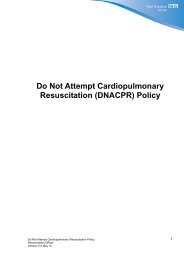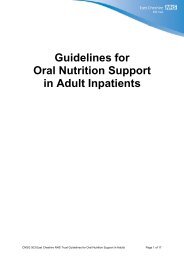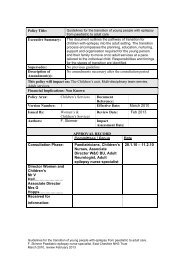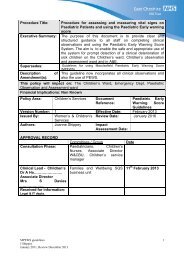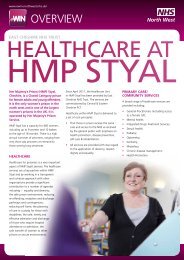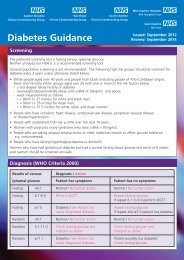Paediatric Diabetes transition Policy 1824.pdf - East Cheshire NHS ...
Paediatric Diabetes transition Policy 1824.pdf - East Cheshire NHS ...
Paediatric Diabetes transition Policy 1824.pdf - East Cheshire NHS ...
You also want an ePaper? Increase the reach of your titles
YUMPU automatically turns print PDFs into web optimized ePapers that Google loves.
=<br />
<strong>Policy</strong> Title:<br />
<strong>Paediatric</strong> and Adolescent <strong>Diabetes</strong> Transition <strong>Policy</strong><br />
Executive Summary:<br />
<strong>Diabetes</strong> Mellitus is a chronic disease which has a major<br />
impact on morbidity and mortality. Caring for children and<br />
young people with diabetes is a complex process which must<br />
be firmly focused on the child or young person and their family<br />
and other carers supported by health care professionals who<br />
have skills and expertise in all aspects of diabetes<br />
management. NICE guidelines (2004) recommend that children<br />
and young people with Type 1 diabetes should be offered an<br />
ongoing integrated package of care by a multi-disciplinary<br />
paediatric diabetes care team; this includes smooth <strong>transition</strong><br />
from paediatric to adult services.<br />
Supersedes:<br />
New <strong>Policy</strong><br />
Description of .<br />
Amendment(s):<br />
This policy will impact on: <strong>Paediatric</strong> diabetes services, Adult diabetes services<br />
Financial Implications: Non Known<br />
<strong>Policy</strong> Area: Children’s Services Document<br />
Reference:<br />
Version Number: 1 Effective Date: February 2013<br />
Issued By: Family and Well being Review Date: January 2016<br />
Authors:<br />
Surendran<br />
Chandrasekaran and<br />
Nicola Birtwistle<br />
Impact<br />
Assessment Date:<br />
September 2012<br />
Consultation Phase:<br />
Clinical Director Families<br />
and Well Being BU<br />
Dr A Ho………………..<br />
Children’s Service’s<br />
Manager D<br />
Baillie……………….<br />
Received for information:<br />
APPROVAL RECORD<br />
Committees / Group<br />
<strong>Paediatric</strong>ians, Children’s<br />
Nurses, Mel Barker<br />
Parents of children with<br />
diabetes<br />
Young people with diabetes<br />
Families and wellbeing SQS<br />
meeting<br />
Date<br />
11 th December 2013
Contents<br />
Section<br />
Content<br />
Page number<br />
Section 1<br />
Section 2<br />
Section 3<br />
Section 4<br />
Section 5<br />
Section 6<br />
Section 7<br />
Section 8<br />
Section 9<br />
Section 10<br />
Section 11<br />
Section 12<br />
Introduction<br />
Key elements for effective <strong>transition</strong><br />
Purpose<br />
Background to the service<br />
Age ranges and Clinics<br />
Philosophy of <strong>transition</strong><br />
Preparation for <strong>transition</strong><br />
Timings and age<br />
Process of Transition<br />
Audit tool<br />
References<br />
Appendix.<br />
3<br />
4<br />
4<br />
5<br />
5<br />
6<br />
6 – 7<br />
7 – 8<br />
8<br />
10<br />
11<br />
12<br />
2
SECTION 1: INTRODUCTION<br />
<strong>Diabetes</strong> Mellitus is a chronic disease which has a major impact on morbidity and mortality.<br />
Caring for children and young people with diabetes is a complex process which must be<br />
firmly focused on the child or young person and their family and other carers supported by<br />
health care professionals who have skills and expertise in all aspects of diabetes<br />
management. NICE guidelines (2004) recommend that children and young people with Type<br />
1 diabetes should be offered an ongoing integrated package of care by a multi-disciplinary<br />
paediatric diabetes care team; this includes smooth <strong>transition</strong> from paediatric to adult<br />
services.<br />
Evidence indicates that many young people are lost to follow up when transferred to an adult<br />
system increasing the already significant risk of premature morbidity and mortality (DCCT<br />
1983) The National Service Framework for <strong>Diabetes</strong> (NSF 2001) Standard 6 and NSF for<br />
Children and Young People “Growing into Adulthood” (2006) highlights <strong>transition</strong>al care as<br />
an integral component of care for all young people and stresses the importance of smooth<br />
effective <strong>transition</strong> organised in partnership with the young person.<br />
A smooth <strong>transition</strong> is further supported by the intercollegiate report “Bridging the Gaps:<br />
Health Care for Adolescents” [2003], guidelines from the Royal College of Nursing [2004],<br />
“You’re Welcome” standards for adolescent-friendly services [DoH 2005] and is in keeping<br />
with the objectives of “Every Child Matters” [DfES 2004] and “Every Young Person with<br />
<strong>Diabetes</strong> Matters” (DOH 2007)<br />
Definition of <strong>transition</strong><br />
Transition is a “planned, purposeful movement of the young person from a child centred to an<br />
adult orientated health care system”. It is a process which evolves over a considerable period<br />
of time and should not be considered an event. (Blum 1993)<br />
Transitional care is a multi-dimensional, multi-disciplinary process that addresses not only<br />
the medical needs of young people as they move from a children’s service to a young<br />
persons services but also their psychosocial, educational and vocational needs and the<br />
needs of their parents.<br />
The aims of <strong>transition</strong>al care are to:<br />
1. Provide high quality, co-ordinated, uninterrupted health-care that is patient-centred, age<br />
and developmentally appropriate and culturally competent, flexible, responsive and<br />
comprehensive with respect to all persons involved;<br />
2. Promote skills in communication, decision-making, assertiveness and self-care, selfdetermination<br />
and self-advocacy;<br />
3. Enhance the young person’s sense of control and move towards independence<br />
4. Provide support for the parent(s)/guardian(s) of the young person during this process<br />
5. Maximise life long functioning and potential [McDonagh 2003,2005a].<br />
3
SECTION 2: Key elements for an effective <strong>transition</strong> programme<br />
1. A written policy<br />
2. A preparation period and education programme with an individualised approach, which<br />
addresses psychosocial and educational/vocational needs, provides opportunities for<br />
adolescents to express opinions and make informed decisions and gives them the<br />
option of being seen by professionals without their parents.<br />
3. A co-ordinated transfer process with a named co-ordinator and continuity in health<br />
personnel when possible.<br />
4. Administrative support<br />
5. Primary health care and social care involvement.<br />
(Viner 1999, DoH 2003.2004.2006, McDonagh 2005a)<br />
SECTION 3: Purpose<br />
This policy sets out the guidance to ensure that <strong>East</strong> <strong>Cheshire</strong> Trust are effective in making<br />
suitable arrangements for the <strong>transition</strong> of young people with type 1 diabetes from a<br />
paediatric to adult /young person’s service.<br />
The aim of this policy is also to ensure that children and families are fully involved in the<br />
process of <strong>transition</strong> and that all staff are aware of the process.<br />
All staff must ensure that all aspects of equality and diversity (E&D) are considered in order<br />
to ensure the child and their family/carer receives appropriate care and treatment and should<br />
include:<br />
• interpreters (for non-English speakers or hearing impaired),<br />
• access, aids and adaptations (for physical, sensory and learning disabled people) and<br />
• religious and cultural factors – for example, ensuring specific dietary advice is provided.<br />
These should be considered prior to any decision relating to <strong>transition</strong>.<br />
For further information about E&D issues, please refer to the Trust policy.<br />
Safeguarding children and young people<br />
<br />
<br />
<br />
<br />
All those who come into contact with children, young people and their families in their<br />
everyday work, including staff who do not have a specific role in relation to<br />
safeguarding children, have a duty to safeguard and promote the wellbeing of<br />
children.<br />
All staff should be familiar with the trust policy and procedure for safeguarding children<br />
and young people, ‘what to do if you are worried a child is being abused’<br />
All health professionals working directly with children should ensure that safeguarding<br />
and promoting their welfare forms an integral part of all stages of care.<br />
All staff should be alert to the potential indicators of abuse and neglect in children,<br />
know how to act on their concerns and fulfill their responsibilities. A range of single<br />
and inter-agency training courses are available. Individual staff members and their<br />
managers will need to identify the correct level of training to enable the individual to<br />
fulfill their roles and responsibilities.<br />
All trust policies, procedures and advice on training is available on the Trust intranet or from<br />
Melanie Barker.<br />
4
References/ related documents:<br />
HM Government (2006) Working together to safeguard children: A guide to<br />
interagency working to safeguard and promote the wellbeing of children. London;<br />
accessed at www.ecm.gov.uk<br />
Lost in Transition – key objectives, RCN<br />
Trust safeguarding children policy-www.eastcheshire.nhs.uk/About-The-<br />
Trust/policies/S/Safeguarding%20children%201645.pdf<br />
SECTION 4: Background to the service<br />
Young Person Transition clinics are currently held on the fourth Wednesday of<br />
every month. The clinics are held in the main out-patients department<br />
between 15:00 hrs and 18:00 hrs. Each patient is offered a 20 minute<br />
appointment.<br />
The <strong>transition</strong> clinics are currently staffed by the Adult physician and the<br />
<strong>Paediatric</strong> <strong>Diabetes</strong> Specialist Nurse (PDSN). There is no dietetic service or<br />
adult diabetes specialist nurse input currently available.<br />
Teenagers who have completed their GCSE’s will be assessed during their regular<br />
clinic visit regarding suitability for Transition. If felt appropriate, a letter of referral is<br />
sent to the Adult Diabetologist and an appointment is sent within a 3 month time<br />
frame.<br />
Teenagers on CSII will be referred to the Adult Diabetologist at Manchester Royal<br />
Infirmary when they approach their 18 th birthday. The PDSN aims to attend the first<br />
appointment with them.<br />
SECTION 5: Age ranges and clinics.<br />
There must be a flexible approach to <strong>transition</strong> which takes into account developmental<br />
readiness and links to other social <strong>transition</strong>s such as leaving school. However for the<br />
purpose of the document age ranges and movement through the clinics have been defined<br />
as follow:<br />
<strong>Paediatric</strong> Clinic up to 16 years old.<br />
Young Person 16/19 years old<br />
Adult 19<br />
Whilst the diabetes team uses the term young people to apply to all age ranges between 12-<br />
25 years and recognises that young people often do not want to be referred to as adolescent,<br />
to avoid confusion and ensure clarity young people attending the paediatric clinic but aged<br />
between 14 to 16 years will be referred to as teenagers/adolescents. Those attending the<br />
young person clinic will be identified as young people.<br />
In <strong>East</strong> <strong>Cheshire</strong> there is no service to bridge the gap between leaving young person<br />
services and entering into full adult services. There is currently no dietetic support or<br />
involvement from the Adult DSN service.<br />
5
SECTION 6: Philosophy of Transition<br />
Aim of the service<br />
<strong>East</strong> <strong>Cheshire</strong> Trust wishes to offer an excellent service to all children and young<br />
people with diabetes and their parents and carers. We will do this by delivering good<br />
quality care that delivers excellent clinical outcomes that are provided by a multidisciplinary<br />
team that empowers the patient and their parents and carers.<br />
A <strong>transition</strong> programme is an essential part of quality care for adolescents with diabetes.<br />
Effective <strong>transition</strong> must recognise that <strong>transition</strong> in health care is only one part of the<br />
wider <strong>transition</strong> from dependent child to independent adult.<br />
Transition services must also address the needs of the parent/guardian(s) whose role is<br />
evolving at this time in their son/daughter’s life and health-care.<br />
In moving from child-centred to adult health services, adolescents undergo a change that<br />
is cultural as well as clinical.<br />
Transition services must be multidisciplinary and involve both paediatric and young<br />
person’s diabetes teams and any other parties involved in the care of the adolescent.<br />
Transition services should also include education, social services and voluntary agencies.<br />
Service development must be undertaken in collaboration with the adolescent involved,<br />
enhancing their sense of control and independence in their healthcare.<br />
Coordination of <strong>transition</strong>al care is critical and a key worker should be identified for each<br />
adolescent to oversee his or her <strong>transition</strong> who links with a counterpart within the young<br />
persons service to ensure seamless <strong>transition</strong>.<br />
Transition is NOT synonymous with transfer. Transition is an active process and not a<br />
single event like transfer. Transition must begin early, be planned and regularly reviewed<br />
and be age and developmentally appropriate.<br />
Transition services must undergo continued evaluation.<br />
SECTION 7: Preparation for Transition<br />
Both the teenager/adolescent and their parent(s) are prepared for <strong>transition</strong> and eventual<br />
transfer to the young person’s service.<br />
<br />
Adolescents are only transferred to the young persons service when they have completed<br />
growth and puberty and have the necessary skills to function in a young persons service<br />
largely independent of parents and staff e.g. decision-making, communication, self-care,<br />
assertiveness. When this is not possible due to cognitive impairment and/or severe<br />
disability, appropriate advocacy, preparation and developmentally appropriate care in the<br />
young persons service should be ensured prior to transfer.<br />
Transition planning is instigated well before the anticipated transfer time – in early<br />
adolescence when a series of educational interventions discuss understandings of<br />
disease, the rationale of therapy, source of symptoms, recognising deterioration and<br />
taking appropriate action, and most importantly, how to seek help from health<br />
professionals and how to operate within the medical system, including primary and<br />
emergency care.<br />
Adolescents are helped to take appropriate responsibility for their diabetes from as early<br />
an age as possible. Furthermore, their parents are encouraged to help them to do so.<br />
The concept of independent visits is introduced well in advance the aim being to see the<br />
teenager/adolescent by themselves for some time during clinic visits from approximately<br />
age 13-14 years. NB Parents must remain involved and should be seen with the<br />
6
In preparation for adolescents to be seen independently, the paediatric clinic will provide<br />
continuity of professionals at each visit. The adolescent and young person is also be<br />
given (where possible) the option of seeing a professional of preferred gender if<br />
necessary. Team members (including departmental visitors’ e.g. medical students) are<br />
kept to a minimum in these individual consultations i.e. a maximum of 1 extra.<br />
A schedule of likely timings and events is given in early adolescence and they should be<br />
involved in developing detailed timings for their own <strong>transition</strong>. Details are documented in<br />
the notes to ensure continuity especially if seen by different members of the multidisciplinary<br />
team.<br />
Leaflets and material about the young persons clinic and <strong>transition</strong> process is provided in<br />
clinic settings from early adolescence.<br />
SECTION 8. Timings and age<br />
Timing of <strong>transition</strong> MUST be flexible and not restricted to age criteria only. Timing of<br />
<strong>transition</strong> and transfer depends on<br />
chronological age,<br />
maturity,<br />
adherence,<br />
independence,<br />
adolescent readiness,<br />
parental readiness.<br />
Flexibility will also be required depending on the adolescent’s medical status. Transfer<br />
should not take place during a crisis e.g. repeated admissions for Diabetic Keto-Acidosis<br />
(DKA)<br />
1. Earliest discussion of <strong>transition</strong> to adult care<br />
This should take place at 10 or 11 years during their last year at primary school. A <strong>transition</strong><br />
plan for ALL teenagers/adolescents should be in place by the age of 14 years and reviewed<br />
at least annually thereafter.<br />
2. Age of effective transfer to young persons service<br />
Aged 16-18 years.<br />
3. Age of effective transfer to adult service.<br />
By age of 19 years.<br />
4. Exceptions to above timing<br />
7
Adolescents on CSII are transferred to the Adult Diabetologist at Manchester Royal Infirmary<br />
before their 18 th birthday. This is because we do not have a local adult CSII service. There<br />
may be exceptions to the transfer of young people aged 18 years old into adult services if<br />
they are undergoing a crisis e.g. development of long term complications which may impact<br />
on their clinic attendance. However this must be discussed with the young person and the<br />
young persons team and transfer take place as soon as possible after the age of 18 years.<br />
SECTION 9. Process of <strong>transition</strong><br />
Preparation for Transition<br />
Initiation & co-ordination of <strong>transition</strong><br />
Every consultant, nurse and dietitian seeing children and young people in the clinic is<br />
responsible for ensuring discussion of <strong>transition</strong> when they see a patient aged 10-11 years<br />
old. Full documentation that this has taken place must be recorded on the patient’s notes and<br />
the diabetes database.<br />
First discussion of <strong>transition</strong><br />
Adolescents will be identified at pre clinic meetings that they will begin <strong>transition</strong> at that<br />
appointment and a member of staff named as the key worker for the patient. This will ensure<br />
<strong>transition</strong> is discussed with every patient and identify the key worker responsible for the<br />
process.<br />
Educational programme<br />
Gradual increasing emphasis on increasing self advocacy for the adolescent patients in<br />
clinic. This includes involvement in decision making, being seen alone and other issues<br />
which impact on their life.<br />
The competency checklist and “goals of diabetes education” that are used by the<br />
paediatric diabetes department will transfer with the young person as they move into the<br />
adult service.<br />
Assessment of readiness for <strong>transition</strong><br />
This will involve Individual discussion with the adolescent and their parents with the diabetes<br />
team. The ultimate decision to move to the young person service lies with the adolescent.<br />
This will be assessed at each appointment following completion of the GCSE’s.<br />
Transfer Process to Young Persons Service<br />
The <strong>Paediatric</strong>ian writes a letter of referral requesting an appointment in the young person’s<br />
clinic and an appointment is given within 3 months. Issues of confidentiality must be<br />
considered in the young persons clinic letters are addressed to the young person, parents<br />
are seen with the young person if they wish. During this time young people will be<br />
encouraged to attend a carbohydrate counting course if available.<br />
Transfer Process to Adult Services<br />
Transfer to the adult service will be around the age of 18 years. This service currently<br />
involves a change of diabetes specialist nursing staff.The PDSN writes to the adult nursing<br />
service to transfer the patient. Consideration needs to be given to transport issue, how to<br />
8
avoid non attendance and identification of key personnel. Young people can choose which<br />
adult clinic they wish to attend i.e. in Macclesfield, Congleton or Knutsford.<br />
Involvement of GP in transfer process<br />
The GP needs to be sent a copy of the <strong>transition</strong> plan.<br />
SECTION 10: Audit Tool<br />
The audit tool is to monitor the effectiveness of the policy by:<br />
Ensuring all staff have access to and have read and understood the policy.<br />
Ensuring that all staff comply with the policy.<br />
Monitoring compliance with the policy: KPI<br />
1. The policy is available in written format and on the Trust intranet.<br />
2. By age 14 a written <strong>transition</strong> plan is recorded on diabetes data base and in a copy is<br />
available in the clinic notes<br />
3. Young people attend the young persons <strong>transition</strong> clinic.<br />
4. Young people attend the adult clinic after transfer.<br />
Ensuring staff have access to and have read and understand the policy.<br />
All relevant staff will be identified on a list and sign to say they have read and understood the<br />
policy. Any new staff will be added to the list.<br />
Acknowledgements:<br />
This policy has been based largely on the policy of Salford Primary Care Trust, which in turn<br />
was based on the template developed at Great Ormond Street Hospital London by Dr<br />
Russell Viner and colleagues; it has been developed further for use in BCH by the BCH<br />
Adolescent Strategic Working Party and has been used with their permission. The North<br />
West <strong>Paediatric</strong> Network thanks them and the <strong>transition</strong> sub-group for its work in making this<br />
policy available.<br />
9
SECTION 11. References<br />
Blum RW. Garell D, Hadgman CH et al. Transition from child-centred to adult health-care<br />
systems for adolescents with chronic conditions. A position paper of the Society for<br />
Adolescent Medicine. J Adol Health 1993; 14: 570-6<br />
Department for Education and Skills. Every Child Matters: Change for Children. 2004, DfES<br />
Publications, Nottingham, UK<br />
Department of Health (2001). National Service Framework for <strong>Diabetes</strong> www.dh.gov.uk<br />
Department of Health (2003). Getting the right start: National Service Framework for<br />
Children. Standard for Hospital Services www.dh.gov.uk<br />
Department of Health (2004). National Service Framework for Children, Young People and<br />
Maternity Services. www.dh.gov.uk<br />
Department of Health (2005). You’re welcome quality criteria. Making health services young<br />
people friendly. (www.dh.gov.uk)<br />
Department of Health (2006). Transition: getting it right for young people. Improving the<br />
<strong>transition</strong> of young people with long-term conditions from children’s to adult health services.<br />
Department of Health Publications, London www.dh.gov.uk/<strong>transition</strong><br />
Department of Health (2007) Every Young Person with <strong>Diabetes</strong> Matters. www.dh.gov.uk<br />
<strong>Diabetes</strong> Control and Complications Trial Research Group(DCCT) (1993) The effect of<br />
intensive treatment of diabetes on the development and progression of long term<br />
complications in insulin-dependent diabetes mellitus New England Journal of Medicine Vol<br />
329 p977-986<br />
McDonagh JE, Kelly DA (2003). Transitioning care of the paediatric recipient to adult caregivers.<br />
Ped Clin N Am 50:1561-1584<br />
McDonagh JE (2005a). Growing up and Moving on. Transition from pediatric to adult care.<br />
Pediatric Transplantation 9:364-72<br />
Royal College of <strong>Paediatric</strong>s and Child Health (2003) Bridging the Gaps: Health Care for<br />
Adolescents. www.rcpch.ac.uk<br />
Royal College of Nursing (2004). Adolescent <strong>transition</strong> care: guidance for nursing staff.<br />
London, (www.rcn.org.uk)<br />
Royal College of Nursing (2008), Central Lost in Transition – moving young people between<br />
child and adolescent services, (www.rcn.org.uk)<br />
Viner RM (1999). Transition from paediatric to adult care. Bridging the gaps or passing the<br />
buck? Arch Dis Child; 81: 271-75<br />
10
Weissberg-Benchell, J, Wolpert, H, and Anderson, BJ, Transitioning From Pediatric to Adult<br />
Care: A new approach to the post-adolescent young person with type 1 diabetes, <strong>Diabetes</strong><br />
care, Vol 30, Number 10, 2007<br />
11
Equality Analysis (Impact assessment)<br />
What is being assessed? Name of the policy, procedure, proposal, strategy or service:<br />
<strong>Paediatric</strong> and Adolescent Transition <strong>Policy</strong><br />
Details of person responsible for completing the assessment:<br />
Name: Nicola Birtwistle<br />
Job title: <strong>Paediatric</strong> <strong>Diabetes</strong> Specialist Nurse<br />
Team: <strong>Paediatric</strong>s<br />
State main purpose or aim of the policy, procedure, proposal, strategy or service:<br />
(usually the first paragraph of what you are writing. Also include details of legislation, guidance,<br />
regulations etc which have shaped or informed the document)<br />
The purpose of the Transition <strong>Policy</strong> is to outline the level of care that will be given to young<br />
people in paediatric services to ensure a smooth <strong>transition</strong> to adult services<br />
2. CONSIDERATION OF DATA AND RESEARCH<br />
To carry out the equality analysis you will need to consider information about the people who use the<br />
service and the staff that provide it.<br />
2.1 Give details of RELEVANT information available that gives you an understanding of who<br />
will be affected by this document<br />
All paediatric patients with diabetes and their families<br />
2.2 Evidence of complaints on grounds of discrimination: (Are there any complaints either from<br />
patients or staff (grievance) relating to the policy, procedure, proposal, strategy or service or its<br />
effects on different groups?)<br />
none<br />
2.3 Does the information gathered from 2.1 – 2.3 indicate any negative impact as a result of<br />
this document?<br />
no<br />
12
3. ASSESSMENT OF IMPACT<br />
Now that you have looked at the purpose, etc. of the policy, procedure, proposal, strategy or service<br />
(part 1) and looked at the data and research you have (part 2), this section asks you to assess the<br />
impact of the policy, procedure, proposal, strategy or service on each of the strands listed below.<br />
RACE:<br />
From the evidence available does the policy, procedure, proposal, strategy or service affect, or have<br />
the potential to affect, racial groups differently? Yes No <br />
Explain your response: Where there is a patient and parents whose first language is not English, staff<br />
should follow the trust interpretation and translation policy – eg in obtaining consent, ensuring parents and<br />
young people understand written information leaflets<br />
GENDER (INCLUDING TRANSGENDER):<br />
From the evidence available does the policy, procedure, proposal, strategy or service affect, or have<br />
the potential to affect, different gender groups differently? Yes No x<br />
Explain your response: No differential impact identified as both genders would be treated the same.<br />
DISABILITY<br />
From the evidence available does the policy, procedure, proposal, strategy or service affect, or have<br />
the potential to affect, disabled people differently? Yes No <br />
Explain your response: If the patient or carers are deaf, then a British sign language interpreter may be<br />
needed (in the future staff will have access to signtranslate – an online translation tool used with a<br />
webcam). If the patient or carer is blind, then information can be recorded in audio format. If the patient<br />
or parent has learning disabilities, staff should ensure information is understood and appropriate methods<br />
of communication are used. There is a picture communications book in the Communication Box on the<br />
ward/dept and staff should be aware of how to access the health facilitator for children with learning<br />
disabilities from <strong>Cheshire</strong> & Wirral Partnership Trust. Staff should ensure they have accessed trust<br />
learning disability awareness training.<br />
Guidance on helping/approaching patients with disabilities can be found in the trust’s ‘Welcoming people<br />
with disabilities’ booklet (also in the communications box.<br />
Young people with learning disabilities may have their transfer delayed, but this would require mutual<br />
discussion and agreement between families and health care professionals.<br />
AGE:<br />
From the evidence available does the policy, procedure, proposal, strategy or service, affect, or have<br />
the potential to affect, age groups differently? Yes No <br />
Explain your response: The policy is specifically targeted at children and young people and their<br />
parents.<br />
LESBIAN, GAY, BISEXUAL:<br />
From the evidence available does the policy, procedure, proposal, strategy or service affect, or have<br />
the potential to affect, lesbian, gay or bisexual groups differently? Yes No x<br />
Explain your response: Care and treatment would be the same regardless of sexual orientation. Same<br />
sex couples would be involved in their child’s care in the same way as heterosexual couples. All staff<br />
have equality and human rights training in statutory/mandatory training.<br />
RELIGION/BELIEF:<br />
From the evidence available does the policy, procedure, proposal, strategy or service affect, or have<br />
the potential to affect, religious belief groups differently? Yes No <br />
Explain your response: There may be drugs used which contain porcine products. If staff do not know<br />
whether a drug contains such products and it is a Muslim patient, they should check with pharmacy at the<br />
13
time.<br />
CARERS:<br />
From the evidence available does the policy, procedure, proposal, strategy or service affect, or have<br />
the potential to affect, carers differently? Yes No <br />
Explain your response: See details in above sections.<br />
OTHER: EG Pregnant women, people in civil partnerships, human rights issues.<br />
From the evidence available does the policy, procedure, proposal, strategy or service affect, or have<br />
the potential to affect any other groups differently? Yes No x<br />
Explain your response: No other issues identified.<br />
4. Safeguarding Assessment - CHILDREN<br />
a. Is there a direct or indirect impact upon children? Yes x No <br />
b. If yes please describe the nature and level of the impact (consideration to be given to all<br />
children; children in a specific group or area, or individual children. As well as consideration of<br />
impact now or in the future; competing / conflicting impact between different groups of children<br />
and young people:<br />
<strong>Policy</strong> only relates to Children so will directly impact children who are having sedation. Any information<br />
given to children/young people should be age appropriate. There is a picture communications book in the<br />
ward communications box.<br />
c. If no please describe why there is considered to be no impact / significant impact on children<br />
5. Relevant consultation<br />
Having identified key groups, how have you consulted with them to find out their views and made<br />
sure that the policy, procedure, proposal, strategy or service will affect them in the way that you<br />
intend? Have you spoken to staff groups, charities, national organisations etc?<br />
All relevant staff groups have had the opportunity to read and comment on this policy. <strong>Policy</strong> has<br />
been amended to reflect their opinions.<br />
6. APPROVAL – At this point, you should forward the template to:<br />
The Trust’s Equality and Diversity Lead lynbailey@nhs.net<br />
The Named Nurse for Safeguarding Children melaniebarker@nhs.net<br />
Equality and Diversity response:<br />
Safeguarding Children response:<br />
7. Any actions identified: Have you identified any work which you will need to do in the<br />
future to ensure that the document has no adverse impact?<br />
Action Lead Date to be Achieved<br />
1. Ensure all staff have been on learning<br />
All staff attend annually<br />
disability awareness training<br />
2. Ensure all staff aware of communications<br />
box and contents<br />
This is<br />
covered by<br />
<strong>Paediatric</strong>s<br />
The<br />
Essentials<br />
which all<br />
staff<br />
August 2012<br />
14
3. Ensure age appropriate information<br />
available<br />
attend<br />
annually<br />
JS and<br />
Ann<br />
Costello<br />
(HPS)<br />
8. Review Date:<br />
Date completed:<br />
The Trust’s Equality and Diversity Lead:<br />
The Named Nurse for Safeguarding Children:… Melanie Barker<br />
15


